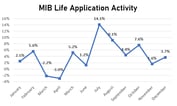Low interest rates and other factors may be making new, stand-alone long-term care insurance (LTCI) policies a lot more more expensive this year.
The same forces also seem to be increasing the cost of “linked-benefit” arrangements, or policies that combine long-term care benefits with life insurance.
The American Association for Long-Term Care Insurance (AALTCI) has given outsiders a peek at LTCI and life-LTC hybrid prices in its latest annual LTCI Price Index analysis.
Resources
AALTCI shows what’s happening to prices for the new policies consumers are buying now, not what insurers are doing to prices for in-force LTCI policies.
For a 55-year-old single male in “select health,” for example, the cost of a stand-alone LTCI policy purchased in Illinois is now about $950 per year with no inflation protection, according to AALTCI. That price is about 9% higher than the annual price for a similar price described in the AALTCI report for 2020.
For a 55-year-old single female in select health, the cost of the stand-alone policy is $1,500 with no inflation protection. That’s about 11% higher than the price of the similar policy included in the 2020 report.









 January 15, 2021 at 09:44 AM
January 15, 2021 at 09:44 AM











